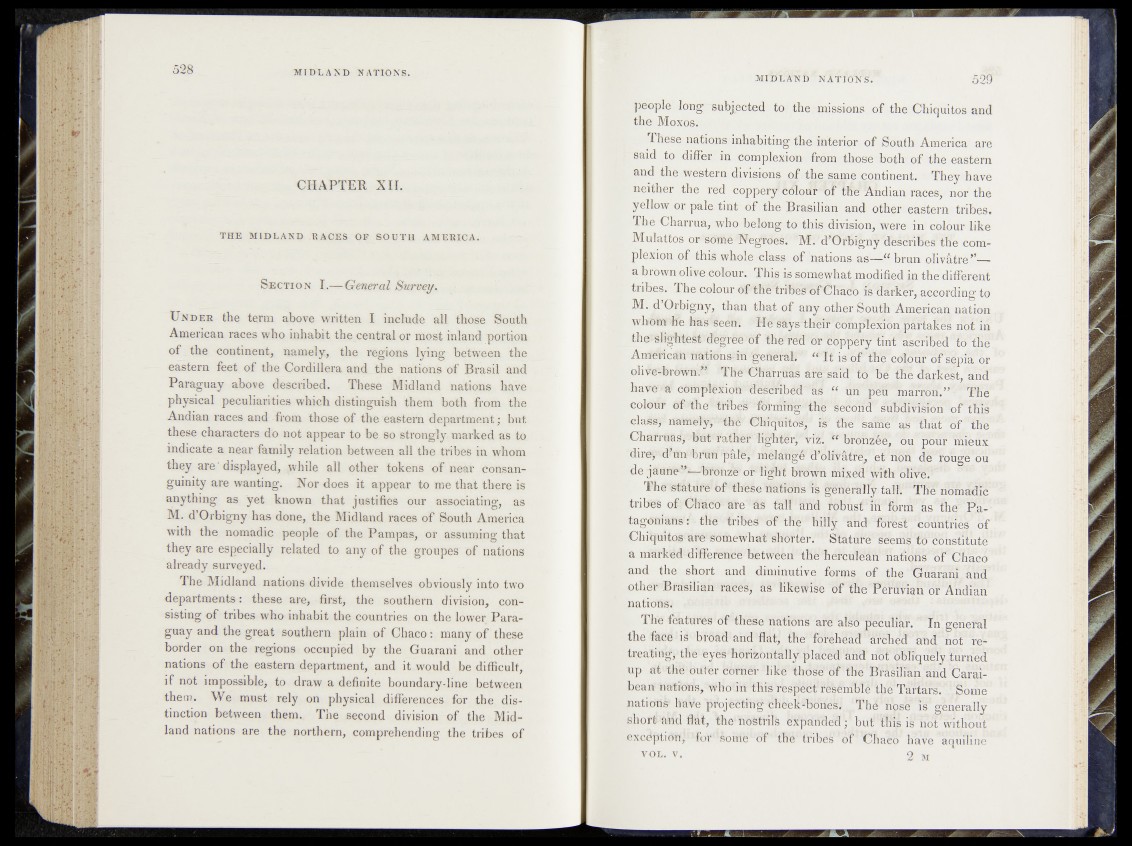
CHAPTER XII.
THE MIDLAND RACES OF SOUTH AMERICA.
Section I.—General Survey*
Under the term above written I include aB those Sooth
American races who inhabit the central or most inland portion
of ithe continent, namely, the regions lying between the
eastern feet of the Cordillera and the nations of Brasil and
Paraguay above described. These Midland nations have
physical peculiarities which distinguish them both from the
Andian races and -from, those of the eastern department; but
these characters do not appear to be so strongly, marked as to
indicate a near family relation between all the tribes in whom
they are displayed, while all other tokens of near consanguinity
are wanting. Nor does it appear to me that there is
anything as yet known that justifies our associating, as
M. d’Orbigny has done, the Midland races of South America
with the nomadic people of the Pampas, or assuming that
they are especially related to any of the groupes of nations
already surveyed.
The Midland nations divide themselves obviously into two
departments: these are, first, the southern division, consisting
of tribes who inhabit the countries on the lower Paraguay
and the great southern plain of Chaco: many of these
border on the regions occupied by the Guarani and other
nations of the eastern department, and it would be difficult,
if not impossible, to draw a definite boundary-line between
them. We must rely on physical differences for the distinction
between them. The second division of the Midland
nations are the northern, comprehending the tribes of
people long subjected*. toUhe missions of the Chiquitos and
the
^C^ffsfi'Diations inhabiting the interior of l&öiith America- are
~ said| differ in complexion from those both of "the eastern
Énd the western divisÿoriMQfe th^same Continent. s T h ^ h av e
'neither the fed cp p p e r/M o fll^W t^m d ian races, nor the
We|èrô7 or pale;!tint: of the Bfesüian and otherreastern tribes.
The, Pharma, who belong torthisd|g^ötf,4weve inJ colour like
Mulattos or%<Mé Pd*Ö r^i^n^lMöriWeS? ffiè complexion
of this wholeydassf of brun olivâtre
a brown o liv é^ lo u rT h is the different
tribe's; :‘Thetcolour ^P'flï^rî^^PêlmcD ^^arl^/aeoordin^-to
M. d than that of any oteen^uth Amepca^ nation
whbm -he ha^eeM H J^âÉys t héîf^^ipfe^mr^lrfafeI nol^in
th e îd igM e i t s ^ r ^ f t h é ^ e d f e r ^ p f ^ l i r rÆ ^ ^ d ^ t h e 0
,A u ^ c a ttm tien ^M 'fefrëf’a ir “ It i ^ ó f 'l h ^ c d@ f ^ ^ i a% '
oliiO-brown ** Tlfe^Ohâfrr#!! arcfeiaPd** (b tffî daritM, ancf
h a vM : ’’-,feThe
l^ lo ô r df^eMHfe^MR§hjmÉ$ i h e '^ Æ S î v W ^ ^ o f * this
elafsf f^hfqfîftol^ is' the^la^e^al**’fhaPof1' the ’
Chafruas,"Bbt'Tather fr|P|ʧr,1 vfÜ ** bróh^l^t *^^P^ur mieux?
d ir^ ! df ùn’*fc]fljfr ^e^rou^^bu
de j ö ö n ^ ^ ^ b n ^ pPli^ft Ifröiiri û lfx ^ wlllï frSve!^
Thë‘*sfàtdfë* bf ‘ tbëie fetiÔés f t |^ ê r â ïîy, tall. ThW
tribes pfiCbâbc^i&e^És fâlPlMd ISfe^sF®Mÿ r r r t i% ÿ j | a ^
tagtó&rls^ i ■ tfaé tribè^W tÂ%pMîlî^ e ^ i& rie l^ f
Chiquitos ârë^Éïthewhat Wéf tlr^ S f e tù ^ i^ f^ ü l^ ^ ^ h sm u te S
and the short and d im in u ti^p fo p i||0f^fhe '^ l a p m .alnf1
other Brasiliah rab’os, âs likewise Ö f '^
nations.
The feàfoi^cjifNMte * Tn^geneftl
the facërisf bfdatd and'flâ|| Ihe^fS^èhbad^l^^Pahâ^hM* re^
treath%! thé hbrikbn^ill^iila^WbW nW^lque*^ lurnèS"
up at the outer Bhtnei like th o ^ ■0f tbb*BrBihahiand Carainaticrtlà’
ha¥e pfejt'ôtihg «Üè’eK-Mrféfei^ ThdTfmslP is* ^herally
short à^d 0*àt, tee’ho’èfrife S^fâfrdeW^ bu t^m | if^mwithout
exM^iëtt,*r,fo¥,HoiddW^fR^rtth 'e f,OT# Chaêö have aquiline"
VOL. V. 2 I